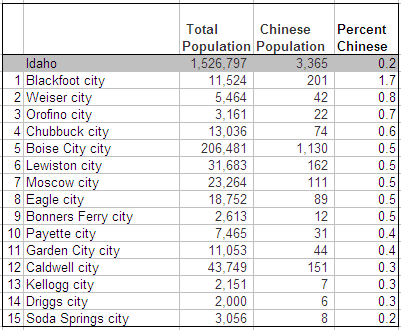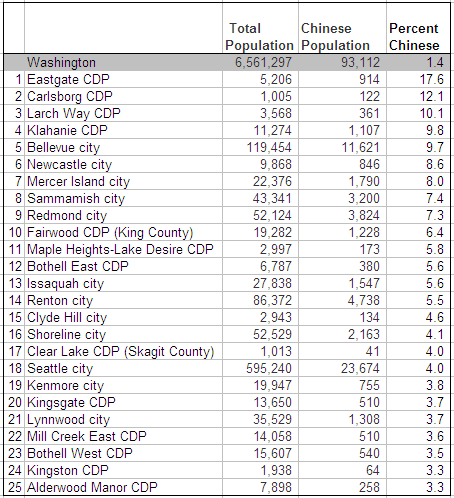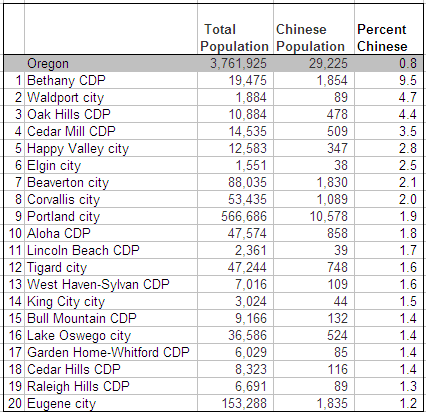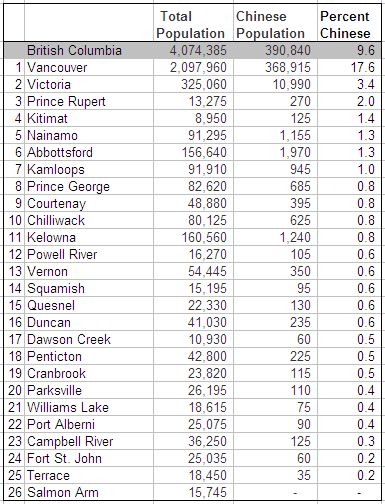In honor of Chinese New Year, I thought it would be fun to crunch some Census numbers to get a sense of where people of Chinese heritage live in the Northwest. In the tables below, I’ve rank-ordered places in the Northwest according to their share of people who self-identify as Chinese.
As you’ll see, a couple of interesting stories emerge. British Columbia, and especially the Vancouver metro area, have a far greater share of people of Chinese descent than any other place in the Northwest. And in the states, the historical Chinese population centers in Portland and Seattle have given way to newer Chinese settlements in the suburbs.
Now, let’s dig in. First up, here’s a look at Washington:
(CDP means “Census Designated Place,” which often refers to unincorporated places.)
In national terms, a remarkably large share of Washington’s population is Chinese. Only five other states claim a larger percentage (Hawaii, California, New York, Massachusetts, and New Jersey, but just barely.) Interestingly, despite the city of Seattle’s rich historical legacy, Chinese populations are far more prevalent in Seattle’s eastside suburbs around Bellevue. In fact, the real story of Chinese settlement today seems to center on Bellevue, which boasts nearly half as many people of Chinese descent as Seattle, a place roughly five times bigger.
Scanning the list, you probably won’t recognize all those place names unless you’re a geography whiz. So here’s a quick run-down for some of the less familiar ones: Carlsborg is just west of Sequim on the Olympic Peninsula; Larch Way is sort of east of Lynnwood; Klahanie is basically on the Sammamish Plateau; Fairwood and Maple Heights-Lake Desire are both southeast of Renton; and Clear Lake is east of Burlington in Skagit County.
Figures of Oregon, Idaho, and British Columbia are below the jump.
Oregon has substantially fewer people of Chinese lineage, but with some intriguing geographic diversity.
As in Washington, the old center city’s historical legacy of Chinese settlement has given way to suburban patterns. By far the dominant area in Oregon is Portland’s western suburbs along Highway 26 near Hillsboro and Beaverton. That region includes Bethany, Oak Hills, Cedar Mill, Aloha, West Haven-Sylvan, Garden Home-Whitford, Cedar Hills, and Raleigh Hills. King City and Bull Mountain are southwest of Tigard.
Farther afield, you’ll find both Waldport and Lincoln Beach on the Oregon Coast, while Elgin is located in remote northeast Oregon.
Idaho has very few people of Chinese descent:
I’ll let readers Google the place names if they’re so inclined. Idaho once had relatively large Chinese settlements, but these have largely faded from the state.
Finally, here’s a look at British Columbia with a note of caution: figures for BC are not to be compared to figures for the states. The numbers refer to somewhat different categories and come from different data sources. (More detail about that in my “notes and methods” section below.) Also, keep in mind that this picture of BC shows metropolitan areas, rather than individual cities or places, so we’re looking at much larger clusters of people.
Now, despite the fact that I said not to compare the figures for BC to the states, I’m going to do it anyhow. It’s clear that British Columbia is far more influenced by Chinese settlement than any other place in the Northwest. In fact, it dwarfs even Hawaii, the state with the highest share of Chinese residents. Yet outside the Vancouver and Victoria metropolitan areas, the rest of British Columbia looks surprisingly like Idaho, Oregon, and Washington with most places hosting only a small share of people claiming Chinese heritage.
Okay, that’s enough of the numbers. Now get out there and enjoy ushering in the Year of the Dragon.
Notes and methods: For US jurisdictions, I used data from the US Census Bureau’s 2006-2010 American Community Survey 5-year estimates. Data refer to residents who self-identify as “Asian alone” and list “Chinese” as their ethnicity. (In other words, these data omit people of two or more races who identify as Chinese.) My figures refer to people who identify as either Chinese or Taiwanese, a debateable choice on my part, but one that ultimately affects the numbers very little because there are very few people of Tawainese descent in the Northwest states. Also, my tables exclude places with total populations less than 1,000.
For BC, I used StatCan’s data from the 2006 Canadian Census, the most recent available. All data come from “Population Groups (28) and Sex (3) for the Population of Canada, Provinces, Territories, Census Metropolitan Areas and Census Agglomerations, 2006 Census – 20% Sample Data.” To increase the comparability to the US numbers, I counted only those who identified as a single race. Including those who say they are “white and Chinese” would notch up many of the numbers by a couple of tenths of a percentage point. Data in BC are for Census-defined metropolitan areas and census agglomerations. My table includes every such place in BC.
Finally, two quick rants. Census data in Canada is awfully thin (and sometimes expensive) gruel compared to what’s readily available in the United States for free. On the other hand, using the US Census Bureau’s new American FactFinder interface is something akin to wandering in a funhouse, only without the fun.




Comments are closed.